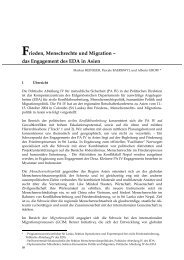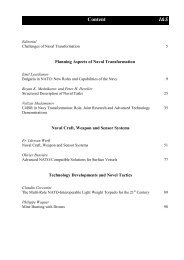Andreas Stamm Eva Dantas Doris Fischer Sunayana ... - ETH Zürich
Andreas Stamm Eva Dantas Doris Fischer Sunayana ... - ETH Zürich
Andreas Stamm Eva Dantas Doris Fischer Sunayana ... - ETH Zürich
You also want an ePaper? Increase the reach of your titles
YUMPU automatically turns print PDFs into web optimized ePapers that Google loves.
28<br />
<strong>Andreas</strong> <strong>Stamm</strong> et al.<br />
ment support and financial incentives) from the concept of “system failure” initially developed<br />
by Edquist (2001).<br />
With a view to identifying system failures and deriving feasible policy options, the authors<br />
look at the chain of the innovation processes from R&D through the demonstration, precommercial,<br />
and supported commercial stages to the fully commercial stage. The two<br />
stages most likely to suffer from system failures are the transition between the demonstration<br />
stage and the pre-commercialisation stage and between the pre-commercialisation<br />
stage and supported commercialisation stage (Foxon et al. 2005b, see also Box 2).<br />
Gross and Foxon (2003) derive sets of policies that push sustainability innovations forward<br />
and should be seen as complementary to environmental policies in the stricter sense,<br />
such as regulations and efforts to internalise environmental costs:<br />
— basic R&D,<br />
— market-creating policies,<br />
— fiscal incentives.<br />
All three policies are relevant for policy makers in developing and anchor countries. However,<br />
even if countries manage to raise public R&D spending, as announced in some ambitious<br />
plans, the absolute financial resources available for the promotion of innovation systems<br />
will probably be limited in the near future (especially under the conditions of the<br />
financial crisis and the economic downturn). Only market-creating policies are not directly<br />
related to increased spending and thus seem most interesting for countries with constrained<br />
public budgets. 17 The authors see here three main options for government action<br />
that are also relevant for developing countries.<br />
— The aim of strategic niche management is to increase the diversity of available technologies<br />
and give cleaner technologies opportunities to mature through learning-bydoing<br />
and learning-by-interacting. One important tool in this respect is public procurement.<br />
By linking public procurement to specific product and process specifications,<br />
governments can contribute to the creation of geographical and/or sectoral niches.<br />
— Sustainable innovations can also be promoted by what has been referred to as backloading<br />
support, e.g. by awarding prizes for the development of technological solutions<br />
that pursue particular environmental objectives.<br />
— A complementary approach consists in setting long-term, outcome-based targets or<br />
obligations designed to allow cleaner technologies to gain a certain share of the market.<br />
One example is the Zero Emission Vehicle Program in place in California since<br />
1990. The regulation requires automakers to make available a certain percentage of<br />
different types of emission-free vehicles for sale or in demonstration programmes in<br />
California. 18<br />
17 This does not imply that these measures cost nothing at all. Linking public procurement with high environmental<br />
standards will usually imply not buying the cheapest artefact on the market. Feed-in tariffs for<br />
renewable energies usually imply higher electricity costs that have to be paid by consumers. Enforcing<br />
high environmental standards for products may result in higher production costs that may be passed on<br />
to the consumer.<br />
18 http://www.ucsusa.org/clean_vehicles/solutions/advanced_vehicles_and_fuels/californias-zero-emission<br />
-2.html, last accessed Oct.15, 2009.<br />
German Development Institute / Deutsches Institut für Entwicklungspolitik (DIE)
















